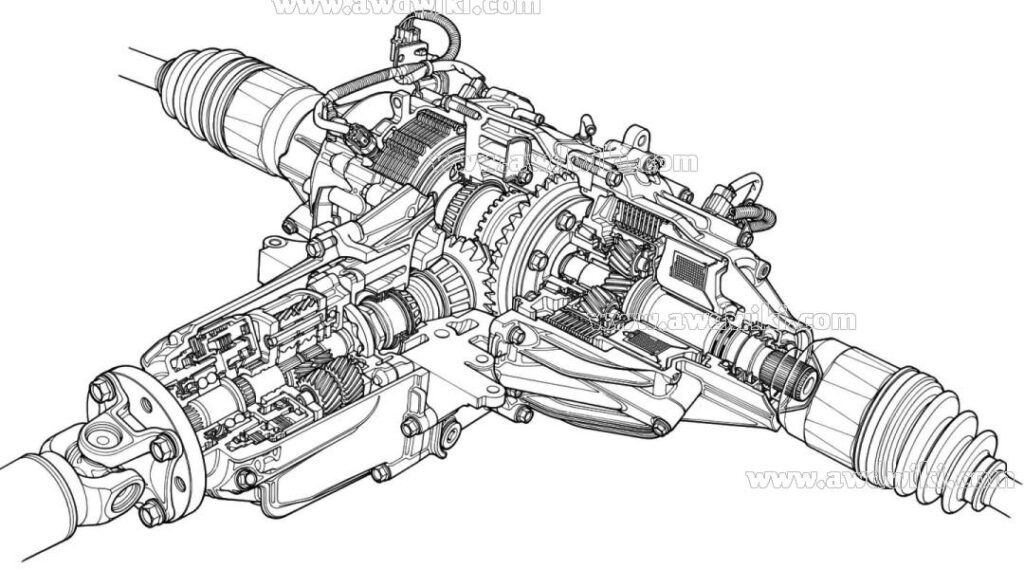Whether your Asian Import is front-wheel drive (FWD), rear-wheel drive (RWD), four-wheel drive (4WD), or all-wheel drive (AWD), power must be delivered to at least one pair of left and right wheels so the vehicle can move. This is made possible by the differential. The differential is the component that distributes power from the vehicle’s transmission, while allowing the wheels to be powered and to rotate at different speeds.
A differential is so named because two wheels on a drive axle need to be able to both receive power, and also turn at different rates of speed. The differential basically allows each wheel to spin freely of the other, while still providing power to both. If one wheel is spinning slower when turning, the differential mechanism will keep driving the other wheel without any jerking, binding, or skidding.
If a vehicle did not have a differential, the driving wheels would be locked together and forced to spin at the same speed, making turning difficult, and increasing the chance of losing control of the vehicle. The absence of a differential would also be hard on the vehicle drivetrain because one tire would have to grab and slip on the road surface to maintain the same speed as the other. This force would transmit through the axle from one wheel to the other and place a huge strain on the axle components as well as the tires.
At least one differential is found on all modern cars, SUVs, and trucks, as well as Asian Imports. In front-wheel drive vehicles, the differential is typically built into the transmission or transaxle, and shares the transmission fluid. On a RWD vehicle with a front-mounted engine, the differential is in the rear and has its own housing and lubrication. In the case of 4WD vehicles, there are typically separate front and rear differentials built into fixed axles and possibly a differential integrated into the transfer case which rests in between them. In AWD vehicles there are not only front and rear differentials, but also a center differential, which is typically integrated into the transmission. AWD vehicles need a differential between each set of drive wheels, and also one between the front and back wheels as well, because the front wheels travel a different distance through a turn than the rear wheels.
The differential may have its own housing and fluid, it may be integrated into the transmission housing and share the same fluid as the transmission, or it may be integrated into the transfer case and share the same fluid as the transfer case. Differentials contained within the transmission and transfer case follow the same maintenance and inspection requirements as the transmission and transfer case. All differentials require oil. Inspecting and changing differential oil are two of the most overlooked vehicle maintenance tasks. Heat, friction, and metal on metal contact eventually break down the fluid, which inevitably wears and weakens gears and bearings and leads to failure.
Differential oil contained in its own housing is sometimes referred to as gear oil. It is thicker than engine and transmission oil and designed to perform under the high pressure of gears mashing together. The gear oil splashes throughout the housing, lubricating gears, bearings, and clutch packs. The purpose of differential oil is to cool and lubricate the differential. Without the oil, the differential would overheat due to metal on metal contact and burn itself out.
Due to normal wear and tear, differential oil may contain small metal particles. Often, differential fluid fill and drain plugs are equipped with a magnet to attract and hold these particles, and to keep them from circulating through vital components. These magnets are not intended to compensate for neglect and abuse, and should not be thought of as a replacement for regular maintenance. A substantial presence of metal particles on the magnet may be evidence of failure within the differential.
It is important to regularly inspect the differential(s) for any damage, leaks, or other concerns, and also to inspect the differential fluid level and condition. Differential fluid may leak from the axle shaft seals, pinion seal, cover gasket, vent malfunction, plugs, or any transaxle or transfer case gasket or seal if the differential is located inside these components. A good way to determine if there are problems with the differential is to test drive your vehicle with the radio off and listen carefully while turning, and driving at both slower and highway speeds.
Do not overlook the differential(s) in your vehicle. To avoid costly repairs and keep your differential in optimum working condition, have your vehicle’s differential and differential fluid inspected at Automotive Instincts. Follow the manufacturer’s recommendation regarding fluid type and how often it should be replaced. If the differential oil is contaminated, shows evidence of metal particles, or is black in color, it is time to replace it, and Automotive Instincts will perform that service for your Asian Import.
When buying a used vehicle, you need to make sure the differential is in good shape and the oil is not excessively contaminated, otherwise, the vehicle may soon need expensive repairs.

Automotive Instincts can inspect the used car to make sure the differential for any damage.
